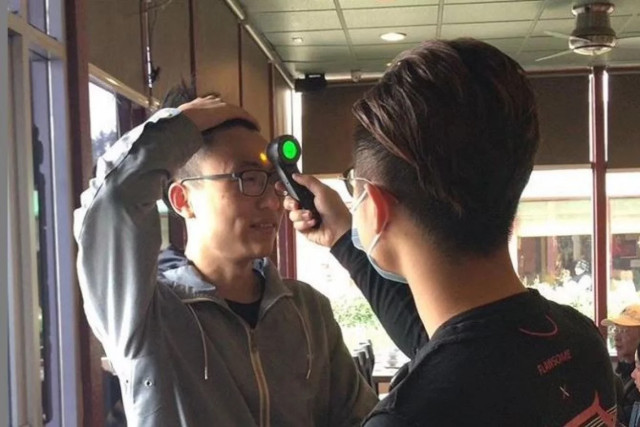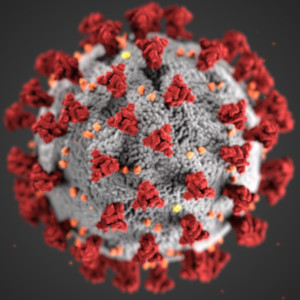The COVID-19 crisis is now officially a pandemic according to the U.S. Centers for Disease Control (CDC), and it’s beginning to effect our relationship with food. There’s good news and bad news on that account. And I’m sorry to have to tell you that the news is mostly bad…
 One Chinese restaurant chain in California, Sichuan Impression, has started
One Chinese restaurant chain in California, Sichuan Impression, has started
checking customers for fevers before letting them into the establishment.
Earlier this week, the CDC started referring to the COVID-19 situation as a pandemic, one step up from its previous ‘epidemic’ status. As of yesterday, it was estimated that there were more than 119,000 cases of COVID-19 around the world, some 4,300 of which had resulted in deaths. That just escalated public concern over the novel coronavirus, and resulted in increasing fear about catching the disease.
Can you get it through food?
On the up side, the CDC says it’s unlikely you’ll contract COVID-19 through the food you eat. In answer to one of the most-frequently-asked questions at its website, the CDC has posted the following:
“Coronaviruses are generally thought to be spread from person-to-person through respiratory droplets. Currently there is no evidence to support transmission of COVID-19 associated with food. Before preparing or eating food it is important to always wash your hands with soap and water for 20 seconds for general food safety. Throughout the day wash your hands after blowing your nose, coughing or sneezing, or going to the bathroom.
“It may be possible that a person can get COVID-19 by touching a surface or object that has the virus on it and then touching their own mouth, nose, or possibly their eyes, but this is not thought to be the main way the virus spreads.
“In general, because of poor survivability of these coronaviruses on surfaces, there is likely very low risk of spread from food products or packaging that are shipped over a period of days or weeks at ambient, refrigerated, or frozen temperatures.”
Restos taking precautions
On the down side, we reported a few days ago that Tim Horton’s and Starbucks have temporarily suspended their anti-pollution programs under which customers were offered a discount on their Coffee if they brought in their own reusable cups. The chains say the didn’t want their employees catching COVID-19 by touching containers that customers had been using.
We now hear that some Costco outlets are suspending their famous free sampling programs for fear of spreading COVID-19.
MGM resorts is closing the buffet restaurants in all its Las Vegas locations citing COVID-19 concerns.
According to NBC, one Chinese restaurant chain in California, Sichuan Impression, has started checking customers for fevers before letting them into the establishment.
In general, the restaurant industry has taken one of the worst beatings of any segment of the economy over the COVID-19 crisis. In spite of the fact that you have to come in contact with COVID-19 in moisture droplets from another person, the usual social media and general fear mongering are in full force. The misguided folks who think you can catch it from going to a Chinese restaurant or eating Chinese food are as crazy as the Trump-basers who believe their President’s assertions that the coronavirus us a ‘big hoax’.
Should we stop sharing food at restaurants?
So much for the romantic tradition of ordering a desert with two spoons. Or sharing appetizers, or the communal ‘family style’ serving of mains and sides.
Dr. Isaac Bogoch, an infectious diseases specialist with the University of Toronto and the University Health Network, told Global News: “COVID-19 is a respiratory virus, and we know that people who have symptoms can certainly transmit the infection to close contacts. […] If people are sharing food, the virus may contaminate the food that they’re eating or on the fork or knife that they’re sharing. And that’s a perfect way to transmit this to other people.”
Nancy Walton, director of the Daphne Cockwell School of Nursing at Ryerson University, explained why close contacts are dangerous: “Being close to someone, and they’re coughing or sneezing on you, and a droplet gets around your eyes, mouth or nose. Or droplets get on your hands, and you then touch your eyes, mouth or nose.”
My take
I agree wholeheartedly with Bogoch and Walton, that it’s easy to get COVID-19 in circumstances where you are dining in public. But I also concur with the CDC, that there’s a low risk of contracting COVID-19 through the food you eat, provided you wash your hands and cooking tools frequently when preparing it. That’s a basic lesson all professional cooks are taught in the first week of culinary school. You already know how I feel about the conspiracy theorists and superstitious folks who insist that COVID-19 is a hoax.
If you have any doubts about COVID-19 and how it relates to your food and dining habits, ask your doctor.
~ Maggie J.

